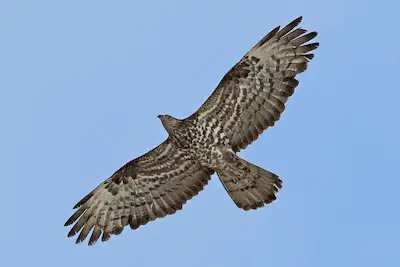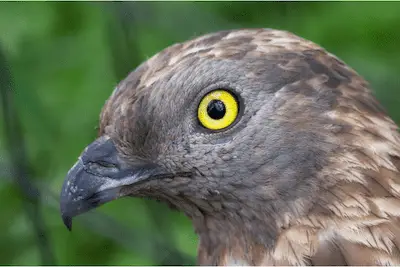European Honey Buzzard
(Pernis apivorus)
The European Honey Buzzard is a unique raptor in Europe, as it is the only raptor species that feeds on Wasps and Bumblebees, almost to the exclusion of everything else.

In addition to its unusual diet, the European Honey Buzzard has also been intensively studied due to its long-range migratory behavior, which takes it to equatorial Africa and back every year.
A great way to observe European Honey Buzzards is at “pinch points” on their migration routes in early autumn, which are corridors and straits where they concentrate during migration.
One of the best places to watch migrating European Honey Buzzards is Gibraltar, where thousands of Honey Buzzards congregate every year in September, just before they cross the Mediterranean sea.
European Honey Buzzard facts
The European Honey Buzzard is a specialist that feeds almost exclusively on Wasps, Bumble Bees and other hymenoptera species. Due to this diet, it is a strictly migratory raptor that is only encountered in Europe during the summer months.
European Honey Buzzard size
The European Honey Buzzard is a medium sized raptor with long wings that is similar in size to Common Buzzards, Black Kites, and Western Marsh Harriers.
- Wingspan: 119-145 cm
- Length: 51-60 cm
- Weight: 530-1,050 g (female), 515-945 g (male)
The long wings and relatively short tail of the European Honey Buzzard are ideal for soaring in thermal currents, which it does extensively (both for foraging and during migration).
Appearance
Looks very similar to the Common Buzzard, both in terms of overall size, proportions, and coloring. Can be distinguished from the Common Buzzard based on details of its coloring, as well as having a longer neck and a more slender tail.

Sexual dimorphism
Similar to almost all raptor species in Europe, female European Honey Buzzards tend to be larger than males, although there is considerable overlap in size between the two sexes.
Lifespan
A maximum age of 29 years has been documented in the wild.
Scientific name and taxonomy
The scientific name of the European Honey Buzzard is Pernis apivorus. It is monotypic (meaning there are no known subspecies). While the European Honey Buzzard resembles the Common Buzzard (Buteo buteo), the two species are in fact not closely related. So the European Honey Buzzard is actually not a real buzzard species.
European Honey Buzzard distribution
The European Honey Buzzard breeds in most of Europe, excluding the southernmost part of Spain, the northernmost part of Scandinavia, as well as Iceland and Ireland. Outside of Europe, its range extends eastwards to western Siberia.
European Honey Buzzard habitat
The European Honey Buzzard prefers lowland forest country interspersed with clearings and open areas. Builds its nest in the forest, but forages both in the forest and in open countryside. In its wintering range it is found both in rainforest and farmland areas.
European Honey Buzzard population size
While there are no exact figures for the European Honey Buzzard population size, it is estimated to be somewhere between 110,000 and 160,000 breeding pairs. It’s difficult to get accurate numbers because the Honey Buzzard tends to be secretive, and resembles the Common Buzzard, with which it shares most of its range.
The largest population is thought to be in the European part of Russia, with up to 80,000 breeding pairs. Current population estimates are partially based on the numbers of migrating Honey Buzzards counted at key locations on their travel routes.
European Honey Buzzard behavior
The most common behavior witnessed from European Honey Buzzards is soaring on thermal currents, similar to Common Buzzards and other raptors. Otherwise it tends to be secretive and difficult to observe.
Feeding and diet
The main food source of the European Honey Buzzards are the larvae of waps, bumblebees, and hornets. It gains access to these larvae by digging their nests out of the ground. Hymenoptera nests are spotted either while soaring, or while perched on a tree. Secondarily, the European Honey Buzzard also feeds on other insects and small vertebrates, such as frogs, rodents, and reptiles.
Breeding
Builds a medium sized nest in coniferous or deciduous trees. The female lays 1-3 eggs, which are incubated for up to 37 days. After hatching, the young stay in the nest for up to 47 days, and continue to be fed for several weeks after leaving the nest.
European Honey Buzzard migration
The European Honey Buzzard is strictly migratory, and every year performs a long distance migration to equatorial Africa, where it winters in rainforests and farmland.
Every autumn, thousands of European Honey Buzzards are observed migrating along what is called the “Western European-West African Flyway”, which is a series of corridors and straits that Honey Buzzards follow on their route south.
Similar to many other raptors adapted to soaring in thermal currents, the European Honey Buzzard prefers not to cross large bodies of water (which don’t have any thermal currents), and hence crosses the Mediterranean sea at its narrowest straits, such as Gibraltar.
During migration, European Honey Buzzards don’t feed, and wait until they reach their wintering grounds before breaking their fast.
European Honey Buzzard conservation status
The overall population of European Honey Buzzards appears to be stable, and because of this it has been classified as a species of “Least Concern” by BirdLife International. However, similar to many other raptor species, it doesn’t do well in landscapes with intense industrial agriculture, and so needs to be monitored.
Preservation (or regeneration) of suitable habitats for European Honey Buzzards also benefit many other species, making it well worth the effort.
Threats
The main threats to the European Honey Buzzard are destruction of habitat due to changes in agricultural practices, as well as the use of pesticides and reduced numbers of Hymenoptera populations.
